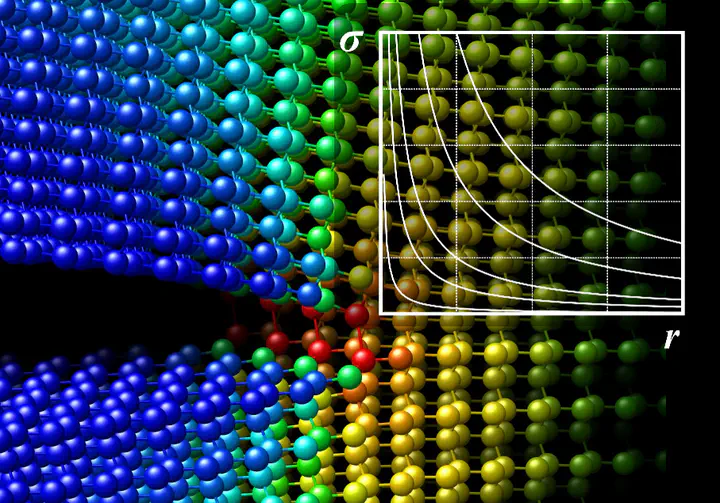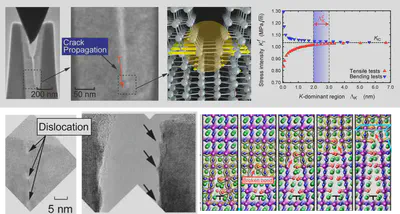Science of Fracture and Strength of Materials

Toward Unbreakable Materials
Our research is aimed at understanding the fundamental mechanisms that why materials mechanically fail and how to create materials that do not break. By controlling light and electronic environments, we have discovered that brittle and fragile materials such as glass can behave like strong and tough metals.
Science toward “Unbreakable Material”
- Stronger than the “theoretically strongest”-
What would the world be like if we could create materials that were so strong that they would never break? Today’s machines and structures are all designed based on the strength of materials that human beings can handle. If we can create materials that are strong enough not to break, it will bring about innovation in all aspects of “manufacturing.
We are conducting research to elucidate the structural and mechanical strength of materials from the root, and to control and design the ultimate constituent elements of materials such as atoms and electrons, in order to freely provide innovative high-strength functions that exceed the ideal strength that was thought to be the limit of strength.

Related Publication
-
Hiroyuki Hirakata, Kyohei Sano, Takahiro Shimada
Reversible control of intrinsic shear strength of a ZnO single crystal through electron-beam-induced hole state
Journal of Materials Research, 21, 4438 (2021) -
Hiroyuki Hirakata, Shigekazu Homma, Hiroki Noda, Shumpei Sakaguchi, Takahiro Shimada
Effects of excess electrons/holes on fracture toughness of single-crystal Si
Journal of Applied Physics, 133, 035101 (2023)
Fracture Mechanics in Nanoscale World
-Toward the Universal Law of Fracture-
Nanomaterials are used in electronic devices such as smartphones and tablets, as well as power devices, sensor devices, and bio-compatible precision instruments. Nanomaterials have become the backbone of our social infrastructure. On the other hand, it has recently become clear that these nanomaterials exhibit mechanical properties that are completely different from those of macroscopic materials we are familiar with, and their elucidation is urgently needed.
We are conducting research on nanomaterials to clarify their strength properties and fracture mechanisms. We have shown that the conventional idea of fracture in macroscopic materials can break down in nanomaterials. We have also discovered a new fracture criterion that holds even in the microscopic world, and are expanding our research to elucidate the general laws of fracture.

Related Publication
-
Takahiro Shimada, Kenji Ouchi, Yuu Chihara, Takayuki Kitamura
Breakdown of continuum fracture mechanics at the nanoscale
Scientific Reports, 5, 8596 (2015) -
Takashi Sumigawa, Takahiro Shimada, Shuhei Tanaka, Hiroaki Unno, Naoki Ozaki, Shinsaku Ashida, Takayuki Kitamura
Griffith criterion for nanoscale stress singularity in brittle silicon
ACS Nano, 11, 6271 (2017) -
Takahiro Shimada, Kai Huang, Le Van Lich, Naoki Ozaki, Bongyun Jang, Takayuki Kitamura
Beyond conventional nonlinear fracture mechanics in graphene nanoribbons
Nanoscale, 12, 18363 (2020) -
Takashi Sumigawa, Takahiro Shimada, Kai Huang, Yuki Mizuno, Yohei Hagiwara, Naoki Ozaki, Takayuki Kitamura
Ultrasmall-scale brittle fracture initiated from a dislocation in SrTiO3
Nano Letters, 22, 2077 (2022)
Eigenvalues describing “Instability” of Materials
-Health monitoring of materials-
When an external force is applied to a material, it will deform and eventually fail to maintain its structure, leading to its destruction. In addition, when an external electric or magnetic field is applied to a material, the electric polarization or magnetic order inside the material is disturbed, and the material loses its original electric and magnetic functions. These are “unstable phenomena” in which the structure or function of a material exhibits irreversible behavior in response to an external field. In order to design and safely operate mechanical structures and electronic devices, it is necessary to know in advance when and how such structural and functional instabilities occur.
We have developed indices to indicate the stability and instability of systems, and have proposed a criterion (instability criterion) to indicate “when” and “how” an arbitrary material system can become unstable to an arbitrary external field.

Related Publication
-
Takahiro Shimada, Satoru Okawa, Shinichiro Minami, Takayuki Kitamura
Simplified evaluation of mechanical instability in large-scale atomic structures
Materials Science & Engineering A, 513-514, 166 (2009) -
Yoshitaka Umeno, Takahiro Shimada, Takayuki Kitamura
Dislocation nucleation in a thin Cu film from molecular dynamics simulations: Instability activation by thermal fluctuations
Physical Review B, 82, 104108 (2010) -
Takahiro Shimada, Kenji Ouchi, Ichiro Ikeda, Yoshiyuki Ishii, Takayuki Kitamura
Magnetic instability criterion for spin-lattice systems
Computational Materials Science, 97, 216 (2015) -
Le Vab Lich, Takahiro Shimada, Jie Wang, Takayuki Kitamura
Instability criterion for ferroelectrics under mechanical/electric multi-fields: Ginzburg-Landau theory based modeling
Acta Materialia, 112, 1 (2016)